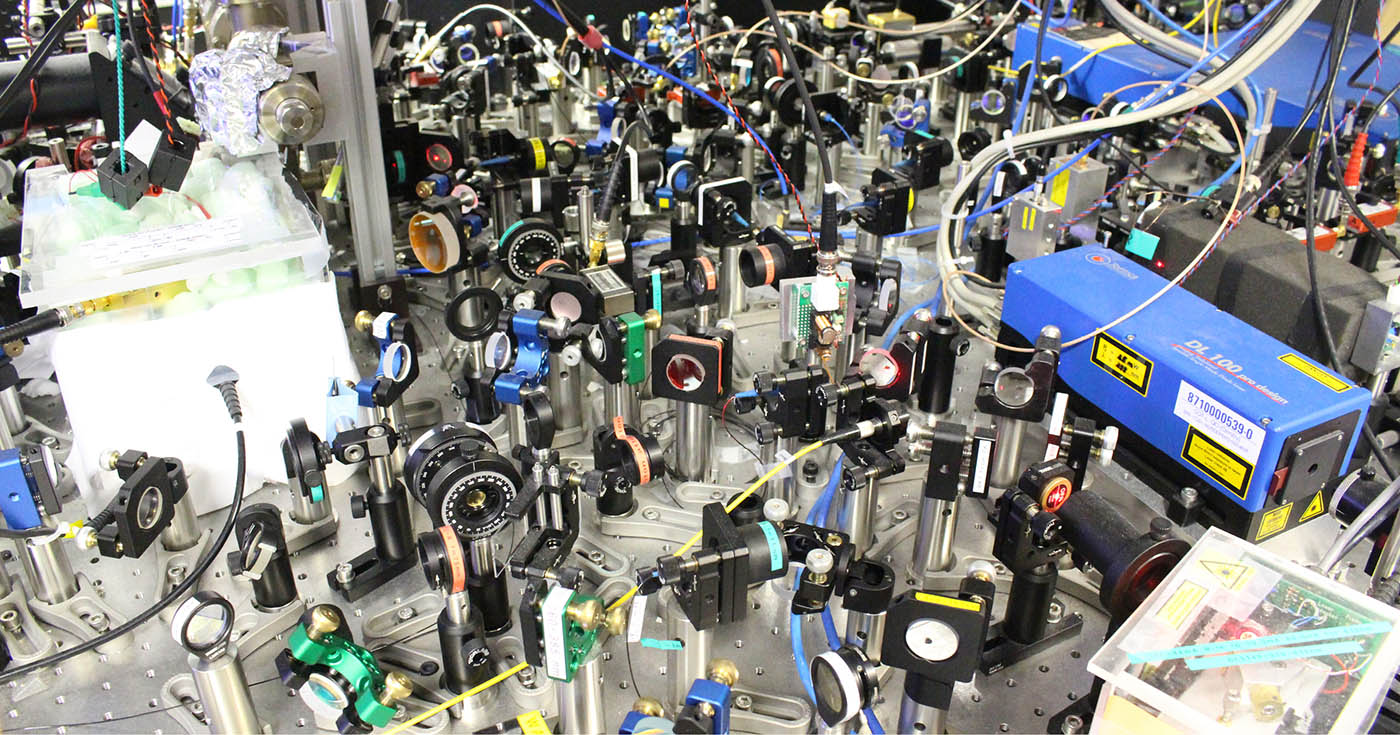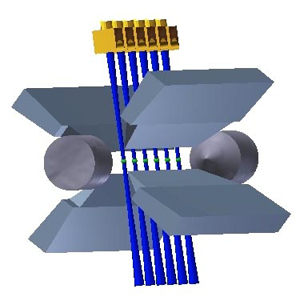Highlights
Getting cross-Kerr with trapped ions
 A table full of equipment provides fine control over the behaviour of two or three trapped Yb+ ions in this CQT lab.
A table full of equipment provides fine control over the behaviour of two or three trapped Yb+ ions in this CQT lab.
CQT researchers have exploited the vibrations of trapped ions to explore a phenomenon known from optics. The technique offers new tools for experiments in quantum thermodynamics and quantum computing.
CQT's Shiqian Ding, Gleb Maslennikov, Roland Hablutzel, Huanqian Loh and Dzmitry Matsukevich describe their work in a pair of papers published in Physical Review Letters. The journal features one of the letters as an Editor's Suggestion, an endorsement given to fewer than 20% of its papers.
Cool ions
For the experiments, the team use lasers to cool Ytterbium ions, 171Yb+, until they are almost perfectly still. The ions, trapped by oscillating and static electric fields inside an evacuated metal chamber, are left vibrating with just a few phonons of energy.
Ions trapped in a line may oscillate along the line – an axial or 'breathing mode' – or radially out from the line.
"Usually people speak about these modes of motion as if they're completely independent and they don't interact, but that's not true," says Dzmitry. The group's two papers explore consequences of this interaction.
"We have a very clean demonstration of an effect that people have been thinking about in optics for decades," says Dzmitry, the group's Principal Investigator.
That effect is the cross-Kerr nonlinearity. In optics, the Kerr effect is a change in the speed of light in a material because of the material's interaction with the light's electric field. The cross-Kerr nonlinearity arises when one light pulse affects the propagation of a second pulse, say with different polarisation.
In the trapped ion system, an analogous effect exists in the interaction between different modes of the ions' motion.
Ions repel each other because of their positive charges. That means a vibration in the axial mode affects oscillations in the radial modes (and vice versa) because the ions' separation is changing, changing the forces between them.
Nonlinear effects
In the team's first paper, published October 12, the researchers show this nonlinearity can make two trapped Yb ions behave as a parametric oscillator.
With the configuration properly tuned, they found that one phonon in the axial mode could excite two in the radial mode, or vice versa. It's like making a swing go faster by standing on the seat, squatting up and down at double the frequency of the swing's to-and-fro. (Not a normal swinging motion, but try it: it works!)
For the second paper, published 8 November, the team adjusted the setup so that the frequencies of the axial and radial modes no longer had this resonance. The frequencies of the modes were tuned by adjusting the strength of the electric fields trapping the ions.
Off resonance, phonons do not transfer between modes. However, the presence of a phonon in one mode will still shift the frequency of the other mode.
The researchers measured these shifts in three Yb ions, showing they could get a direct count of the phonons present in the system. The team studied the patterns of phonons in different types of quantum states – namely, coherent, thermal and squeezed. It's these results PRL highlights as an Editor's Suggestion.
Being able to characterise quantum states opens the door to studying the thermodynamics of the system. Quantum thermodynamics is a hot topic as researchers investigate how laws developed for big machines translate to microscopic systems.
Measuring quantum states is also essential for quantum computing. The motional states of trapped ions are candidates for a form of computing known as continuous variable. Control over the transfer of phonons can assist in state preparation and gate operations.
Shiqian, first author on both works, is now a Research Associate at the University of Colorado at Boulder. Huanqian, a co-author on the first paper, has since become a Principal Investigator at CQT and is setting up a new research group. Gleb, Roland and Dzmitry continue to experiment on their trapped Ytterbium ions.
 The plot shows how the oscillation frequency of the axial mode of the ions (illustrated in the cartoon at top left) shifts as more phonons are added into the radial mode (top right). This provides a mechanism to count the phonons in the system.
The plot shows how the oscillation frequency of the axial mode of the ions (illustrated in the cartoon at top left) shifts as more phonons are added into the radial mode (top right). This provides a mechanism to count the phonons in the system.
Learn more
Related Stories
 | Good vibrations for trapped ions January 02 2014 |






